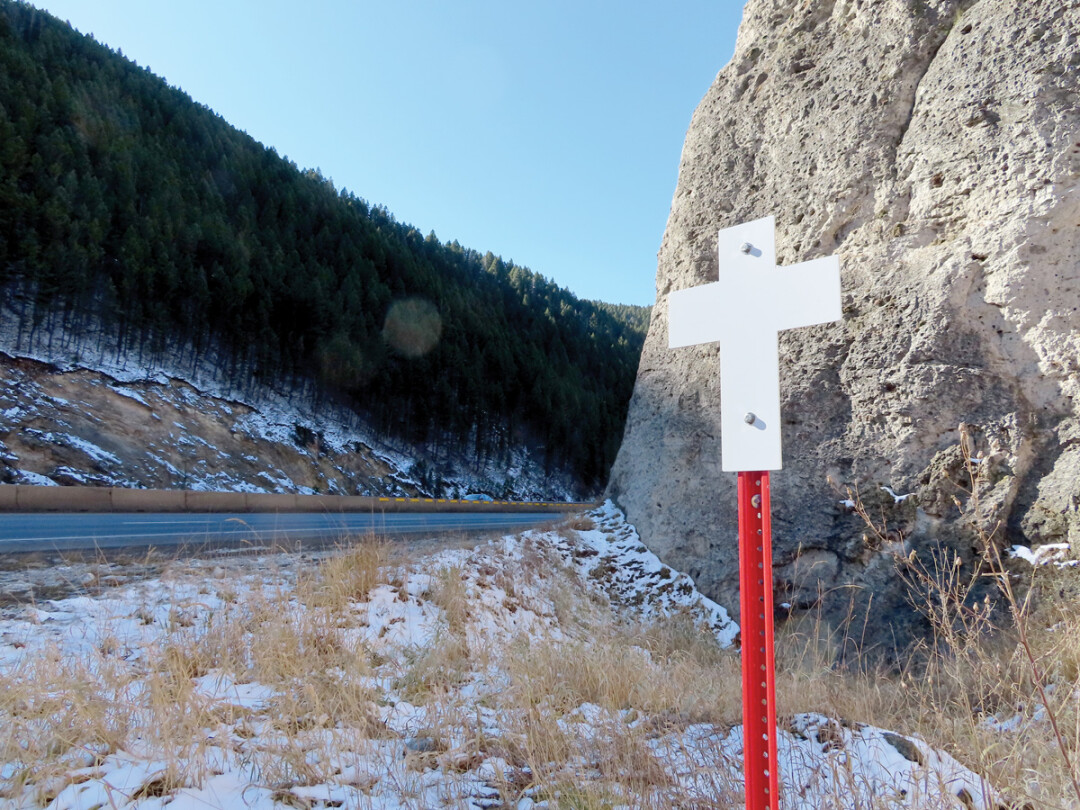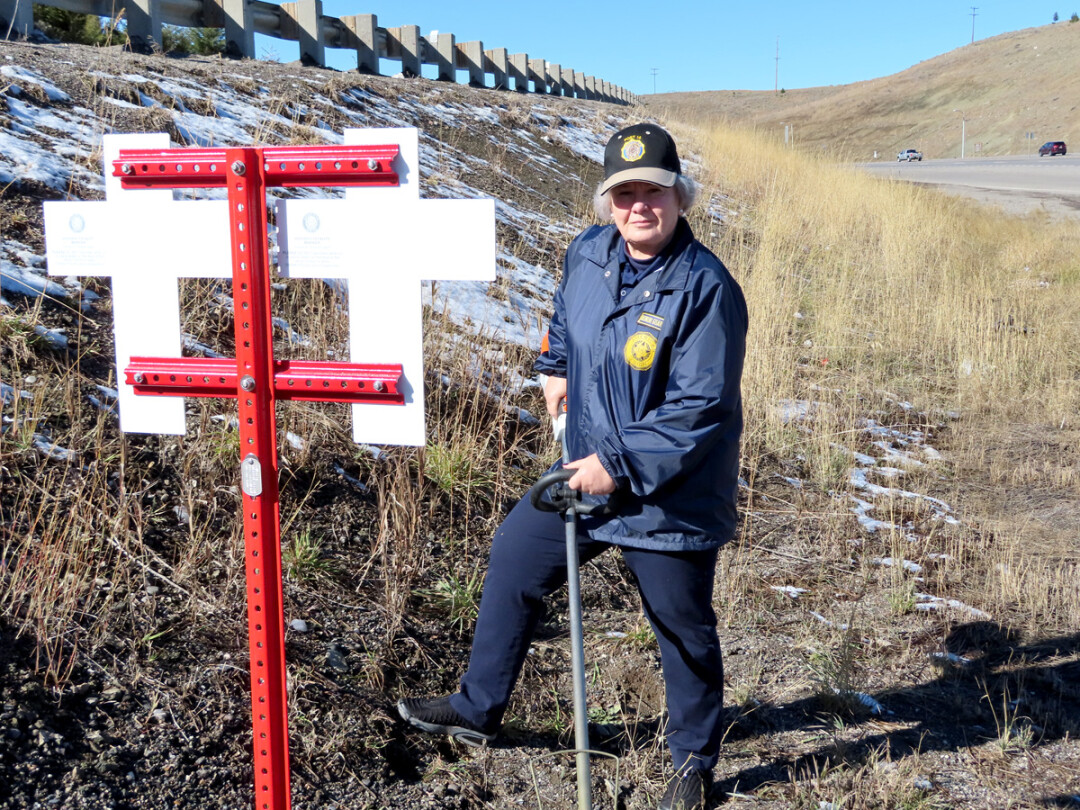Sobering Reminder: Montana’s Fatality Marker Program
Numerous enough to notice, infrequent enough to be startled at seeing, and inspiring reverence, sorrow, sympathy, curiosity, and caution. For over 50 years, the white crosses that mark the sites of fatal traffic accidents along the highways of Montana have affected us all as we drive by, reminding us of the danger of the road, as well as the lives that have been lost on these highways.
The idea to mark fatal traffic accident sites with a white cross was the brainchild of Floyd Earheart, a member of Hellgate American Legion Post #27 in Missoula. He came up with the idea after 6 lives were lost in the area over the 1952 Labor Day weekend. The safety program began as a county, and later district, project for the Missoula American Legion Post. However, the idea was so good that it was soon adopted as a statewide program. The Montana Highway Commission approved the program in January of 1953 with the blessing of “the galloping Swede” J. Hugo Aronson, 14th governor of Montana. Louis Babb, Assistant Adjutant for the Department of Montana at the time, was instrumental in the program’s adoption. He appeared before the Montana Highway Commission and convinced them to adopt the White Cross Safety Program. With this authorization, most of the 132 Montana American Legion Posts participated in the program. Floyd Earheart served as the state White Cross Chairman for several years.
However, this safety program was not acknowledged in writing until a Letter of Instruction was signed by then Director of MDOT, David A. Galt, on November 5, 2001. In January 2007, the Director of MDOT, Jim Lynch, was instrumental in getting the American Legion Highway Fatality Marker Program included on the 2007-2008 Official Montana Highway Map. This provided the American Legion needed visibility and publicity to further the program. In November 2007, Mr. Lynch approved the construction and installation of 5 by 13 feet highway signs on all 25 highway entrances into Montana. These huge blue and white signs state that the White Marker Program is maintained by the American Legion of Montana. It was also in 2007 that the name of the program was changed from the White Cross to the Fatality Marker Program.
The American Legion’s Fatality Markers can be found along state and federal highways, secondary and forest service roads, and even city streets. One white marker is erected for each traffic accident. Since the Fatality Marker Program’s inception over 50 years ago, it is estimated that over 2,500 fatality markers have been erected along Montana’s highways. This represents a cemetery of over 5 acres.
Below, we have provided answers to frequently asked questions about the Fatality Marker program.
ARE THESE MARKERS MEMORIALS?
For over 60 years, the Montana American Legion has been placing markers beside the road in the location of a fatality as a SAFETY reminder, not as a memorial.
Still, many families place wreaths or other decorations on the crosses as a personal memorial to a loved one who died on the road. Obstruction of the white marker with these decorations defeats the purpose of the safety program. However, attaching them below the cross on the metal pole is acceptable. The American Legion encourages people to express themselves, but respectfully asks that the fatality marker itself not be adorned as that reduces visibility and defeats the purpose of this safety program. The white markers serve as a public service message, reminding drivers to drive carefully. They are a sobering reminder of a fatal traffic accident, a place where a human being lost his/her life.
Opinions about these roadside memorials/shrines are mixed. While some people find them offensive, most people see them as places of healing for families who lost a loved one in an accident. Others say they represent a startling safe-driving message for passersby.
Most private memorials have become shrines and are decorated in some manner. More and more, we find personalized memorabilia designed to bring attention to the site. Some memorials are decorated for each holiday, or season of the year. One site included motorcycle parts welded together as a memorial. Another was a large pile of rocks, that could have caused another fatality.
Under the National Highway System Designation Act of 1995, MDOT is charged with maintaining the right-of-way free of encroachments to enable motorists to recover when leaving the roadway. This is required by the Code of Federal Regulations (CFR). If MDOT does not keep the right-of-way free of encroachments, Montana risks losing federal funds. Montana, like most states, has a rule against the homemade memorials.
Not only can they be a distraction, they can be potentially hazardous. Mourners who stop to visit or maintain a roadside memorial not only place themselves in danger, they also put other motorists at risk. Some drivers stop in the roadway and open a door into traffic, allowing even children to exit or enter vehicles near the roadway. We have witnessed individuals unload lawn mowers, to mow the area surrounding a memorial, while still parked on the roadway.
Since it is the responsibility of the local Post to see that white crosses are erected at the site of fatal traffic accidents, each one of the Montana Legion Posts is allocated a certain area of responsibility for erecting and maintaining the white crosses. Each American Legion Post is annually furnished with an instruction sheet with specifications for making the white fatality markers. Instructions are also provided for erecting the white crosses at fatality sites.
No one wants to see a subsequent tragedy result from a previous incident.
WHAT CONDITIONS COULD LEAD TO THE REMOVAL OF A MARKER?
If a family requests the removal of a marker, it will be expeditiously removed. Beyond a request for removal, reasons for removal could include, but are not limited to: if a marker falls into disrepair; if a section of a highway has been reconstructed and corrected the hazard that may have caused the fatality in the first place, and if markers are repeatedly obscured because of excess adornment that leads to the primary safety function being defeated. Markers may also be taken down if they interfere with routine maintenance/mowing, underground utilities, highway medians, bridges, signs, poles, or non-breakaway objects.
WHAT HAPPENS NEXT IF A MARKER IS TAKEN DOWN?
Removed markers that have personal mementos attached will be stored for 30 days to allow the owners to claim the material. If contact information for the owner of the memorial is known, they will be informed of the reason it was removed and where it is being stored if they would like to retrieve it.
Two acceptable alternatives to a roadside memorial are the Adopt-A-Highway Program and the American Legion Highway Fatality Program. These programs allow the deceased to be recognized and honored in a manner conforming to state statutes while giving mourners access to the memorial without compromising highway safety.
DOES THE COUNTY OR THE STATE OF MONTANA PROVIDE THESE MARKERS?
No tax money is used in fabrication, erection, or maintenance of these markers. They are purchased by local posts through fundraisers and donations and placed and maintained by members of the American Legion. The blue and white signs at the entrances of Montana were purchased by the Montana Department of Transportation and are maintained by the American Legion of Montana.
DOES AMERICAN LEGION POST #14 PLACE MARKERS IN THE ENTIRE COUNTY OR STATE?
Post #14 maintains in excess of 125 markers from the edge of Bozeman to Norris on MT 84, Four Corners to the mouth of Gallatin Canyon on SR 191, I-90 from the Valley Center Spur underpass to the Park County line at Bozeman Pass; Jackrabbit (MT 85) to Valley Center Road; Bridger Canyon Road to the Park County Line, and Springhill Road to Flathead Pass. Other Legion Posts are responsible for parts of Montana, however, not all of the Posts in Montana participate in this program.
ARE MARKERS ONLY ERECTED FOR VETERANS?
Fatality markers are erected regardless of whether or not that person or persons served in the Army, Navy, Air Force, Marines or Coast Guard.
WHAT IF WE HAVE LOST A LOVED ONE AND THERE IS NO FATALITY MARKER?
When a highway has been reconstructed and corrects the problem that may have caused the accident, markers are removed permanently. However, if a safety marker has been removed erroneously, destroyed, or misplaced, please contact American Legion Post #14 to assess the issue.
Not all highway fatalities are marked. Not all of the 134 Posts in Montana currently participate in the program. Some areas of Montana do not have a local American Legion Post. Because of these reasons, many stretches of Montana highways do not have fatality markers where a fatal accident has occurred.
For more information about highway fatality markers, feel free to contact Greg Harbac, coordinator for fatality marker program at American Legion Post #14 in Bozeman at P.O. Box 936, Bozeman 59771.




